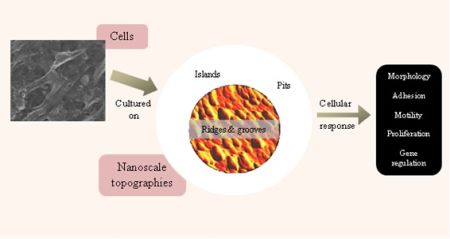|
|
|
|
|
|
| Nanoscale manipulation on the surface of materials could stimulate cells to differentiate into specific tissues - eliminating the use of growth or transcription factors. |
TSUKUBA, Japan, Nov 9, 2016 - (ACN Newswire) - Researchers are trying to find ways to control cellular response in vitro using engineered materials in a continuous pursuit to regenerate injured or diseased tissues. Recent studies have found that nanoscale structure of the materials, on which such cells are cultured, affect how well they proliferate and develop into the tissues they are meant to become.
 | | Cellular characteristics and activities that may be influenced by the interaction between cells and nanoscale topographies. |
Scientists from the University of Malaya in Malaysia, Dr. Belinda Pingguan-Murphy et al., together with Prof. Sheikh Ali Akbar of Ohio State University, reviewed the most recent research on how the nanoscale topographies affect cellular regenerative responses.
For example, human fetal osteoblast cells that are involved in bone formation were found to grow better on materials that had tiny protrusions on their surfaces (11 nanometers in height) compared to surfaces that were either flat or had higher protrusions. They also attached better to surfaces with nanosized pits that were 14 nm or 29 nm deep compared to flat surfaces and surfaces with pits that were 45 nm deep.
Research has also found that the distance between pits or protrusions and whether they are random or highly ordered also affect how osteoblasts and stem cells respond. Additionally, nanoscale grooved surfaces trigger these cells to grow in the direction of the grooves.
Generally, when a material is exposed to a biological fluid, water molecules bind rapidly to the surface followed by the incorporation of chloride and sodium ions. Proteins then adsorb to this surface. The resulting mixture of proteins, as well as their three-dimensional shape and orientation with respect to the surface topography, sends signals to the cells influencing their attachment and spreading.
Further research in this area may lead to the development of clinical prostheses with topographies that can directly modulate stem cell fate, enabling cell growth and development to be tailored to a specific application without using potentially harmful chemicals, write the researchers in their review published in the journal of Science and Technology of Advanced Materials. However, developing low-cost, high-output fabrication techniques that allow for the development of specific nano-topographies is still a limiting factor.
For further information please contact:
Associate Professor Dr. Belinda Pingguan-Murphy*,
University Malaya - Biomedical Engineering
Kuala Lumpur, Wilayah Persekutuan, Malaysia
(*); e-mail: bpingguan@um.edu.my
Ms. Nur Izzati Aminuddin,
University of Malaya - Biomedical Engineering
Kuala Lumpur, Wilayah Persekutuan, Malaysia
Dr. Roslina Ahmad,
University of Malaya - Mechanical Engineering
Kuala Lumpur, Wilayah Persekutuan, Malaysia
Professor Sheikh Ali Akbar,
Ohio State University
Columbus, Ohio, United States
Article information
Pingguan-Murphy, Belinda (*); Aminuddin, Nur Izzati; Ahmad, Roslina; Akbar, Sheikh Ali:
"Osteoblast and stem cell response to nanoscale topographies: a review",
Science and Technology of Advanced Materials Vol. 17 (2016) p.1242999.
http://dx.doi.org/10.1080/14686996.2016.1242999
Journal information
Science and Technology of Advanced Materials (STAM, http://www.tandfonline.com/toc/tsta20/current) is an international open access journal in materials science. The journal covers a broad spectrum of topics, including synthesis, processing, theoretical analysis and experimental characterization of materials. Emphasis is placed on the interdisciplinary nature of materials science and on issues at the forefront of the field, such as energy and environmental issues, as well as medical and bioengineering applications.
For more information about STAM contact
Mikiko Tanifuji
Publishing Director
Science and Technology of Advanced Materials
E-mail: TANIFUJI.Mikiko@nims.go.jp
Press release distributed by ResearchSEA for Science and Technology of Advanced Materials.
Topic: Research and development
Source: Science and Technology of Advanced Materials
Sectors: Science & Nanotech, Science & Research, BioTech
https://www.acnnewswire.com
From the Asia Corporate News Network
Copyright © 2024 ACN Newswire. All rights reserved. A division of Asia Corporate News Network.
|
|
|
|

|
|
|
|